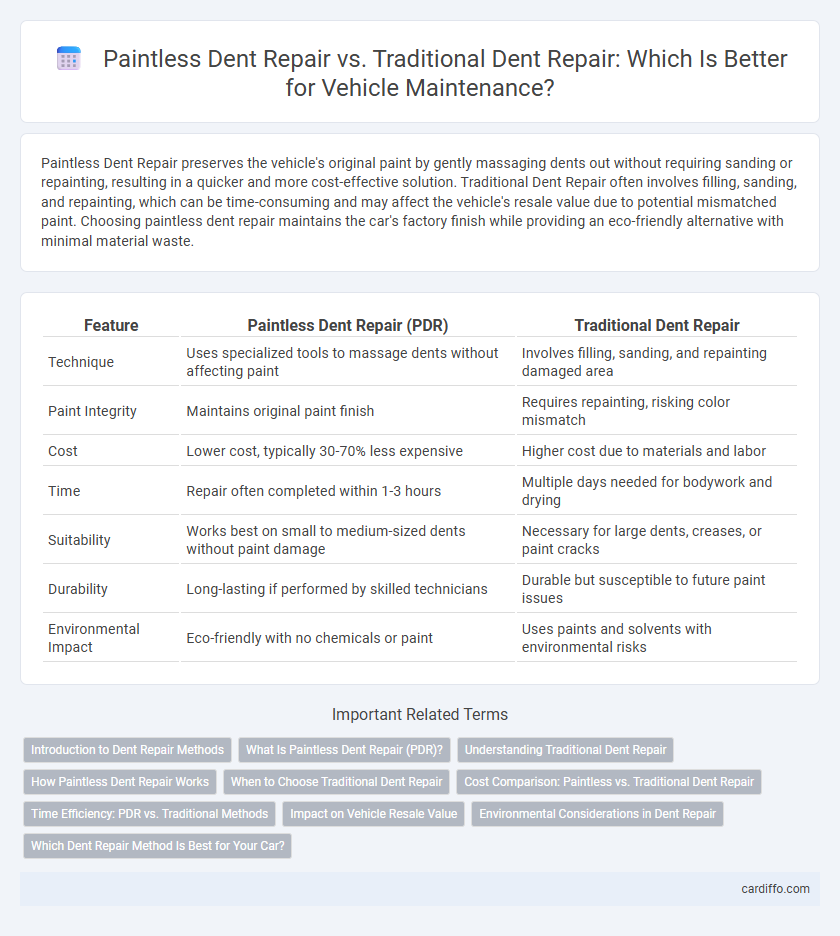Paintless Dent Repair preserves the vehicle's original paint by gently massaging dents out without requiring sanding or repainting, resulting in a quicker and more cost-effective solution. Traditional Dent Repair often involves filling, sanding, and repainting, which can be time-consuming and may affect the vehicle's resale value due to potential mismatched paint. Choosing paintless dent repair maintains the car's factory finish while providing an eco-friendly alternative with minimal material waste.
Table of Comparison
| Feature | Paintless Dent Repair (PDR) | Traditional Dent Repair |
|---|---|---|
| Technique | Uses specialized tools to massage dents without affecting paint | Involves filling, sanding, and repainting damaged area |
| Paint Integrity | Maintains original paint finish | Requires repainting, risking color mismatch |
| Cost | Lower cost, typically 30-70% less expensive | Higher cost due to materials and labor |
| Time | Repair often completed within 1-3 hours | Multiple days needed for bodywork and drying |
| Suitability | Works best on small to medium-sized dents without paint damage | Necessary for large dents, creases, or paint cracks |
| Durability | Long-lasting if performed by skilled technicians | Durable but susceptible to future paint issues |
| Environmental Impact | Eco-friendly with no chemicals or paint | Uses paints and solvents with environmental risks |
Introduction to Dent Repair Methods
Paintless Dent Repair (PDR) utilizes specialized tools to carefully massage dents from the inside of a vehicle's panel without affecting the original paint, preserving the factory finish and reducing repair time. Traditional Dent Repair often involves sanding, filling, and repainting damaged areas, which can be more invasive and time-consuming but necessary for severe dents or paint damage. Understanding these methods helps in selecting the appropriate dent repair technique based on the extent of damage and desired outcome.
What Is Paintless Dent Repair (PDR)?
Paintless Dent Repair (PDR) is a specialized auto body technique that removes minor dents and dings without disturbing the vehicle's original paint. This method utilizes precise tools to gently massage the metal back to its original shape, preserving the factory finish and preventing the need for repainting. PDR is highly effective for hail damage, door dings, and small creases, offering a faster and more cost-efficient alternative to traditional dent repair.
Understanding Traditional Dent Repair
Traditional dent repair involves removing dents by filling, sanding, and repainting the damaged area, which often requires extensive labor and time. The process typically includes using body filler materials to restore the panel's shape, followed by repainting to match the original color, which may lead to potential paint mismatches or durability issues. This method is preferred for severe dents where paint is damaged or the metal is creased beyond simple reshaping.
How Paintless Dent Repair Works
Paintless Dent Repair (PDR) restores vehicle surfaces by meticulously massaging the metal from behind the dent using specialized rods and tools, preserving the original paint finish. Technicians employ precise pressure and leverage techniques to gradually manipulate the dented area, enabling a smooth contour without sanding, filler, or repainting. This method is highly effective for minor dents caused by hail, door dings, or small impacts, offering a faster, cost-efficient, and environmentally friendly alternative to traditional dent repair.
When to Choose Traditional Dent Repair
Traditional dent repair is best chosen for severe dents with paint damage, deep creases, or areas involving plastic parts where paintless dent repair (PDR) is ineffective. This method ensures proper surface preparation, filling, sanding, and repainting to restore the vehicle's original appearance. Complex dents near edges or on body panels with existing paint imperfections also require traditional techniques for durable, high-quality results.
Cost Comparison: Paintless vs. Traditional Dent Repair
Paintless Dent Repair (PDR) generally costs 30% to 70% less than Traditional Dent Repair due to the minimal use of materials and faster labor time. Traditional Dent Repair often involves repainting, filler application, and more extensive labor, which increases overall expenses. Choosing PDR can result in significant savings, especially for minor dents and dings, without compromising vehicle appearance.
Time Efficiency: PDR vs. Traditional Methods
Paintless Dent Repair (PDR) significantly reduces repair time by using specialized tools to reshape dents without removing paint, often completing jobs within one to two hours. Traditional dent repair involves sanding, filling, and repainting, which can take several days due to multiple drying and curing stages. Choosing PDR minimizes vehicle downtime, making it a more time-efficient option for minor dents and hail damage.
Impact on Vehicle Resale Value
Paintless Dent Repair (PDR) preserves the original factory paint, maintaining the vehicle's aesthetic integrity and significantly enhancing its resale value compared to Traditional Dent Repair, which often requires repainting that can diminish the car's market appeal. PDR minimizes the risk of paint mismatches and clear coat inconsistencies, factors that buyers and appraisers closely evaluate when determining resale worth. Choosing paintless methods demonstrates professional maintenance, resulting in higher offers and faster sales in secondary markets.
Environmental Considerations in Dent Repair
Paintless Dent Repair (PDR) significantly reduces environmental impact by eliminating the need for harmful chemicals, paints, and fillers commonly used in traditional dent repair methods. This eco-friendly technique conserves resources by minimizing waste and energy consumption, aligning with sustainable automotive maintenance practices. Choosing PDR supports lower volatile organic compound (VOC) emissions, promoting cleaner air quality compared to conventional repair processes.
Which Dent Repair Method Is Best for Your Car?
Paintless Dent Repair (PDR) offers a cost-effective and time-efficient solution for minor dents, preserving the original factory paint and maintaining your car's resale value. Traditional Dent Repair is more suitable for complex damage involving paint chipping or large dents, as it involves sanding, filler application, and repainting to restore the surface. Choosing the best dent repair method depends on the dent size, location, and paint condition, with PDR preferred for small, paint-intact dents and traditional repair necessary for extensive or paint-damaged areas.
Paintless Dent Repair vs Traditional Dent Repair Infographic

 cardiffo.com
cardiffo.com